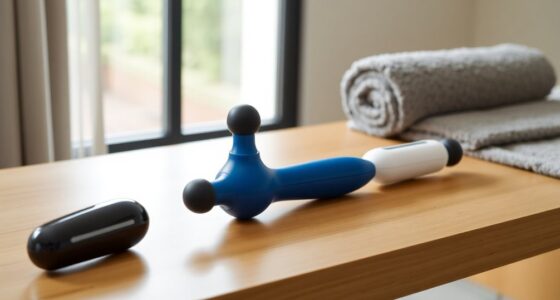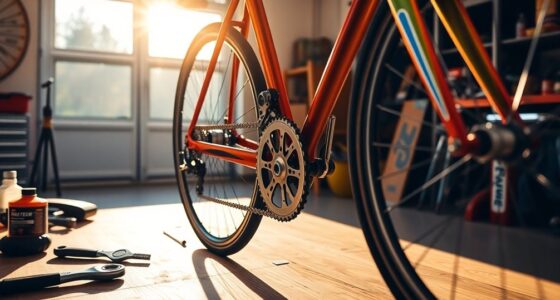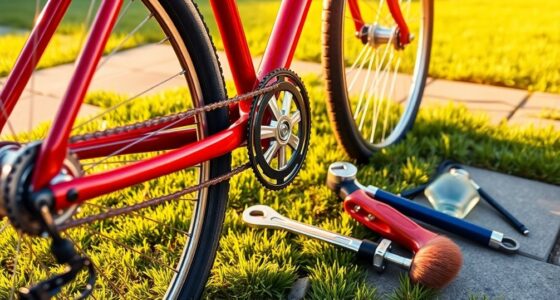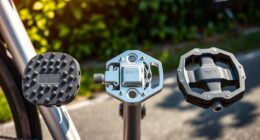Regular bike maintenance is key to safety and smooth rides. Check your tires for proper inflation and signs of wear or debris regularly. Keep the chain lubricated and clean to guarantee efficient shifting and longevity. Inspect brake pads for wear and adjust or replace them as needed for confident stopping. Maintain your gears by cleaning and tuning derailleurs and cables. Incorporating these simple checks will keep your bike in top shape; continue to learn more essential tips for ideal upkeep.
Key Takeaways
- Regularly check and maintain tire pressure, inspecting for wear or embedded debris to ensure safety and ride quality.
- Keep the chain lubricated and clean to ensure smooth shifting and prolong drivetrain life.
- Inspect brake pads regularly and replace when worn to guarantee effective stopping power.
- Tune gears and shifters by adjusting cables and cleaning components for reliable, precise gear changes.
- Perform routine safety checks, including lights and reflectors, to enhance visibility and overall cycling safety.
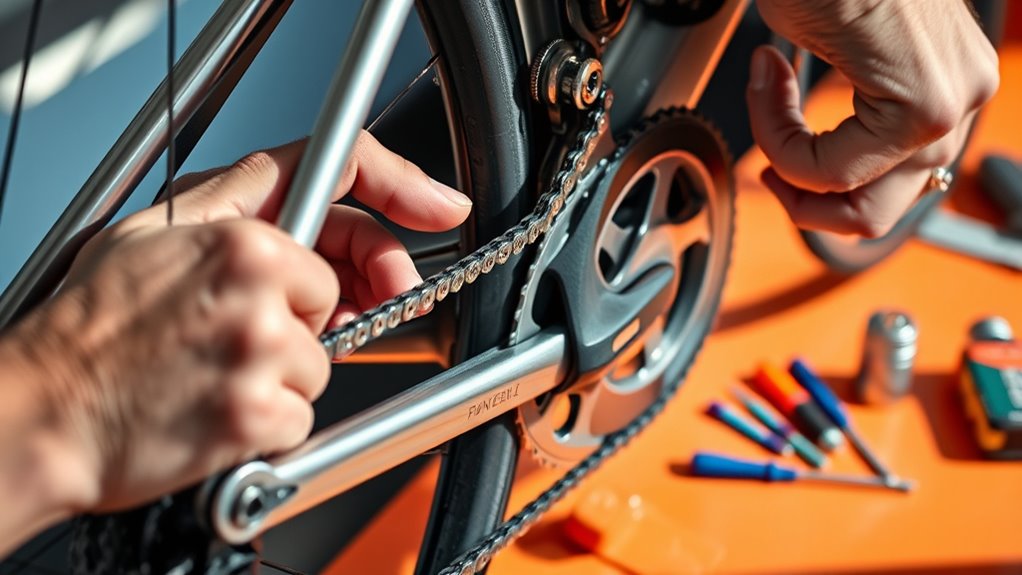
Ever wondered how to keep your bike in top shape? The truth is, regular maintenance isn’t complicated, and a few simple steps can dramatically extend the life of your ride. Starting with the basics, you should regularly check your tires for wear and proper inflation. Under-inflated tires make pedaling harder and increase the risk of flats, while over-inflated ones can make your ride less comfortable and more prone to damage. Invest in a good quality pump and keep a pressure gauge handy. Before each ride, take a moment to inspect your tires, ensuring they’re firm and free of embedded debris or cuts. This simple habit can prevent many common flats and improve your overall riding experience. Additionally, checking your headphone connection compatibility with your cycling device can ensure seamless audio during rides for those who listen to music or navigation prompts.
Next, focus on your chain. A well-lubricated chain ensures smooth gear shifts and reduces wear on other drivetrain components. Every few rides, wipe off any dirt and grime from the chain with a clean cloth, then apply a suitable chain lubricant. Don’t overdo it—excess lube attracts dirt, which can accelerate wear. Spin the pedals backward while applying a light, even coat of lubricant, then wipe off any excess. This routine keeps your chain running quietly and efficiently, saving you money and hassle down the line.
Brakes are equally vital for safety and performance. Regularly check your brake pads for wear; if they’re getting thin, replace them promptly. When you squeeze the brake levers, the pads should contact the rim or rotor firmly without excessive travel. If they feel spongy, or if the brake lever pulls too close to the handlebar, you might need to adjust or bleed your brake system. Keeping your brakes in good condition ensures you can stop quickly and confidently, which is crucial whether you’re steering through city streets or tackling mountain trails.
Lastly, don’t forget about your gears and shifters. Smooth shifting depends on proper cable tension and clean components. If you notice hesitations or slipping when shifting, it’s time to tune your gears. This involves adjusting the derailleur’s limit screws and cable tension, a task that’s straightforward once you understand the basics. Regularly cleaning the derailleur and cassette also prevents grime buildup, making gear changes more precise. Additionally, understanding the importance of contrast ratio in your bike’s lighting system can enhance nighttime safety. By staying on top of these simple maintenance tasks, you’ll enjoy a more reliable, efficient, and enjoyable ride every time.
Frequently Asked Questions
How Often Should I Replace My Bike Tires?
You might wonder how often to replace your bike tires. It depends on riding style, terrain, and tire condition. Check for worn-out treads, cracks, or embedded debris regularly. Typically, replace tires every 2,000 to 3,000 miles or when you notice significant wear. Don’t wait until a flat or blowout occurs—trust your eyes and hands to assess when it’s time for new tires to keep your ride safe and smooth.
What’S the Best Way to Store My Bike Long-Term?
When storing your bike long-term, you wanna keep it in a cool, dry place away from direct sunlight. Make sure to clean it thoroughly and lubricate the chain to prevent rust. If possible, hang it or store it on a stand to avoid tire and frame damage. Cover it with a breathable cloth to keep dust off. Regularly check on it to guarantee everything stays in good shape.
How Can I Tell if My Brake Pads Need Replacing?
To tell if your brake pads need replacing, start by inspecting their thickness. If they’re less than 1/8 inch thick, it’s time for new pads. Listen for squeaking or grinding noises when braking, which also signals wear. Feel for reduced stopping power or a spongy brake lever. If you notice any of these signs, replace your brake pads promptly to guarantee safe, effective braking every time.
What Tools Are Essential for Basic Bike Repairs?
Ever wondered what tools you need for quick bike fixes? You’ll want a set of Allen wrenches, screwdrivers, tire levers, and a pump—these are your essentials. Plus, a multi-tool with various functions can save the day. Keep a chain tool and spare tubes handy for emergencies. With these, you can handle most repairs on the go, ensuring your ride stays smooth and safe.
How Do I Properly Clean and Lubricate My Chain?
To properly clean and lubricate your chain, start by shifting to the smallest gear and applying a degreaser. Use a brush or rag to scrub away dirt and grime, then rinse with water and dry thoroughly. Once dry, apply a suitable chain lubricant, focusing on each link. Wipe off excess to prevent dirt buildup. Regular cleaning keeps your bike running smoothly and prolongs your chain’s life.
Conclusion
Now that you know the basics of bike maintenance, you’re better equipped to keep your ride smooth and safe. Regular upkeep can extend your bike’s lifespan and prevent costly repairs. Did you know that neglecting maintenance can reduce your bike’s efficiency by up to 15%? So, make a habit of checking your tires, brakes, and chains regularly. With just a little effort, you’ll enjoy a safer, more enjoyable cycling experience every time you hit the road.


